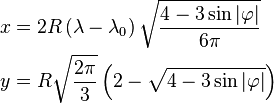Eckert II projection
The Eckert II projection is an equal-area pseudocylindrical map projection presented by Max Eckert-Greifendorff in 1906. In the equatorial aspect (where the equator is shown as the horizontal axis) the network of longitude and latitude lines consists solely of straight lines, and the outer boundary has the distinctive shape of an elongated hexagon.
Description
The projection is symmetrical about the straight equator and straight central meridian. Parallels vary in spacing in order to preserve areas. As a pseudocylindric projection, spacing of meridians along any given parallel is constant. The poles are represented as lines, each half as long as the equator. The projection has correct scale only on the central meridian at latitudes 55°10′ north and south.[1]
The projection's x and y coordinates can be computed as
where λ is the longitude, λ0 is the central meridian, φ is the latitude, and R is the radius of the globe to be projected. Here, y assumes the sign of φ.
See also
Notes
- ↑ John P., Snyder (1989). An Album of Map Projections (U.S. Geological Survey Professional Paper 1453). Denver: US Geological Survey. p. 88.
References
- Snyder, J. P. Map Projections—A Working Manual. U. S. Geological Survey Professional Paper 1395. Washington, DC: U. S. Government Printing Office, 1987.
- Erik W. Grafarend, Rey-Jer You, Rainer Syffus—Map Projections: Cartographic Information Systems, Second Edition, Springer-Verlag Berlin Heildelberg 2014, ISBN 978-3-642-36494-5 (eBook)
External links
| Wikimedia Commons has media related to Eckert II projection. |
- Eckert II at Mapthematics
- radicalcartography.net
- Cartographic Projection Procedures (Pdf) by Gerald I. Evenden
